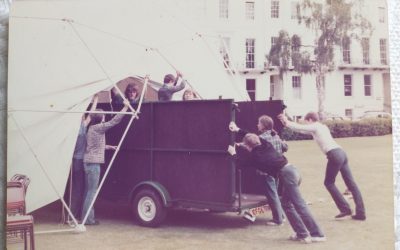 On Saturday there was a lovely article in The Guardian about Paul Barton, a man who plays the piano to elephants at an elephant sanctuary in Thailand. The elephants have often been overworked or mistreated before they come to the sanctuary, but it seems that they enjoy hearing piano music. They come and stand near the piano, sometimes curling their trunks in towards their mouths ‘like a baby sucking its thumb.’
On Saturday there was a lovely article in The Guardian about Paul Barton, a man who plays the piano to elephants at an elephant sanctuary in Thailand. The elephants have often been overworked or mistreated before they come to the sanctuary, but it seems that they enjoy hearing piano music. They come and stand near the piano, sometimes curling their trunks in towards their mouths ‘like a baby sucking its thumb.’
‘Their breathing actually slows down when you play, which tells me they are relaxed and happy’, Paul Barton writes. ‘There was one elephant that would walk away if I played Schubert, but stayed for hours for Beethoven.’
My attention was caught by this bit: ‘I’ve played pre-recorded music in the jungle, but they didn’t seem to react; same with the electric piano. An acoustic piano, where the sounds vibrate off the wood, seems to communicate better with the animals. They have excellent hearing and can pick up sounds through their feet.’
The emphasis on live music reminded me of what I learned when I got interested in the methods of Alfred A. Tomatis, the French doctor who invented a method of stimulating the ear and brain through specially adapted recordings which enhance the upper frequencies. He worked with all sorts of patients from children with autism to adults with depression or communication problems, and singers whose vocal technique had damaged their ability to hear. Essentially, his patients sat and listened on headphones to specially prepared recordings (often of Gregorian chant) with the higher frequencies boosted. Over a period of time this re-balanced the ear. Patients would often report good results. The Tomatis method is highly valued by some, but dismissed by others as pseudo-scientific.
I remember reading that at one point, Tomatis switched from using analogue recordings to using digital ones in his practice. Suddenly his results were less impressive. He looked into how digital recordings are made and found that they are composed of tiny blocks of sound with infinitesimal gaps between them. These gaps are not detectable by the conscious ear, but he developed a theory that the brain could detect them, and in essence refuse to believe in the music. Analogue recording worked better as a therapy because there was actually a continuous flow of sound.
Even more effective than recordings would, of course, be live music made in front of you by a real musician – the soundwaves impacting on you physically. Being in the presence of live music is different from listening to a recording!




After reading about these elephants, a reader has directed me to this interesting post on Stephen Jones’s blog. It’s about the use of ivory on piano keys. Today, the ‘natural’ keys are white, and the ‘flat and sharp’ keys are black. It used to be the other way round. When did it change, and why? Stephen Jones has some intriguing theories.
https://stephenjones.blog/2023/07/24/black-and-white/